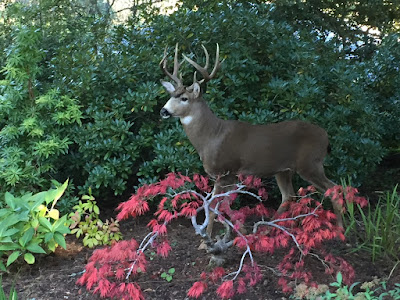Practicing Mindfulness
Last Friday I talked
about mindfulness, the practice of paying attention, staying in the present, and
just observing and accepting our thoughts and sensations without judging them
or being overwhelmed by them. I suggested the exercise of taking a pause to
breathe, count, and then simply notice and name your feeling or emotion when
you start to feel something overtake you. The goal was simply to stay with it —
to stay present — and to be able to choose what you need next rather than just
mindlessly react. Did you try it? Was it hard? For many of us, mindfulness
feels foreign; it’s the exact opposite of how we have been used to moving in
our fast paced, multi-tasking environment. Yet in this time of anxiety and
grief, mindfulness is exactly what we need.
Just like a muscle, mindfulness can
grow stronger with repeated exercise. And like any other new skill,
mindfulness gets easier the more we practice. Here are a couple of easy ways to
build more mindfulness into your day:
- Mindful eating: Turn all your attention to the task when you eat. Before you begin to eat, take a moment to pay attention to the appearance and smell of the food. Take a bite, then put your utensil down and focus on the experience of eating. Bring all your awareness to the task. Chew slowly. Allow yourself to experience the taste, the texture, and the aroma of the food. Do you hear anything? Maybe a crunch when you bite or chew? Use all your senses to experience just that one bite. Feel the sensation as the food leaves your mouth and goes down your throat. Pause before you pick up your utensil again. Repeat.
- Mindful washing: With all the handwashing we’re doing these days, we have endless opportunities to practice paying attention. Slow down as you go to wash your hands. Take a deep breath in, breathe out slowly, and focus your attention as you begin. Use your senses. What do you hear when the water comes on? How does the soap smell? How does it feel in your hand? On your skin? How does the lather look? What do you feel when you move one hand against the other? When you interlace your fingers? When you release them? How does the towel look, feel, and smell?
You can extend this practice into
almost anything you do. Household chores, personal grooming, and outdoor walks
are all great opportunities to practice being more mindful. One fun and easy
way to begin practicing is to mindfully eat a piece of wrapped candy. From the
crinkle of the paper, to the physical sensation of holding the candy and
opening the wrapper, to the color of the candy, to the smell, taste, and
texture as you hold it in your mouth until it disappears, it’s possible to
mindfully engage every sense in the experience. Don’t have wrapped candy on
hand? Try this with a raisin, a cracker, or an apple. The key is to use as many
of your senses as you can and to pay attention to each one of them in turn,
without judging any of them.
I believe that the best way to
practice, though, is to meditate. Where mindfulness helps us to focus on
something specific, meditation can help us learn to let go of judgment about
our thoughts and sensations. There are different kinds of meditation practices.
But mindfulness meditation simply aims to help us clear our mind and observe
the thoughts that do come into it. Here are some myths about mindfulness
meditation:
- You have to be able to turn off all your thoughts to do it
- You have to be able to sit still for a long time without moving
- You have to be able to sit cross-legged on the floor to do it
- There is a right way to do it
- It takes years to learn how to do it properly
The truth is that anyone can
meditate, and part of the point of it is to accept that your mind will wander.
Mindfulness meditation is nothing more than being still, paying attention to
the breath, and gently bringing the mind back to the breath when it wanders
off, as it will. You can start with just a few minutes at a time, and you can
sit on a chair or even lie down to do it. There are lots of resources to help.
I think that Headspace is a good one: Headspace
I haven’t used Calm myself, but I’ve heard good things about it: Calm Both
offer a free trial.
I also recommend Jon Kabat-Zinn’s
work. A Professor of Medicine emeritus at the University of Massachusetts
Medical School, he founded its world-renowned Mindfulness-Based Stress Reduction
Clinic and the Center for Mindfulness in Medicine, Health Care, and Society. You
can purchase CDs or downloadable MP3 mindfulness meditation recordings at his
website: Jon Kabat-Zinn [NOTE: There’s a much bigger
selection of CDs than MP3 recordings.] You can also find guided meditations by
him on You Tube. Here’s one for beginners: Guided Meditation Finally, you may be able to
download electronic copies of his books from your local library. I recommend Full
Catastrophe Living: Using the wisdom of your body and mind to face stress,
pain, and illness for a start. If you choose to buy one of his books, The
Mindful Way through Depression comes with an excellent CD of guided
meditations and is filled with information that is also helpful for anxiety.

Tryon Creek, 4/3/20
Until tomorrow, I am reminded daily
that we are all in this together. Thank you all for the many ways you grace my
life. Take care, be well, and be at peace in your heart.
Love,
Nancie/Mom/Mimi/Grandma



Comments